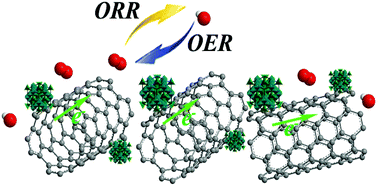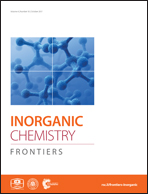Spinel cobalt–manganese oxide supported on non-oxidized carbon nanotubes as a highly efficient oxygen reduction/evolution electrocatalyst†
Abstract
We report an in situ preparation of ultrasmall Co–Mn–O spinel nanoparticles (4.4 nm) supported on non-oxidized carbon nanotubes (denoted as CMO@CNTs) as a bifunctional catalyst for oxygen reduction and evolution reactions (ORR/OER). The preparation process involves the oxidization of divalent metal ions under alkaline conditions and the decomposition of nitrates in aqueous solution containing dispersed non-oxidized CNTs. The synthesized CMO nanoparticles strongly couple with the non-oxidized CNTs, which facilitates electron transfer and improves the catalytic activity. Other composites such as CMO@reduced graphene oxide, CMO@Vulcan X-72R, CMO@oxidized CNTs, and a physical mixture of CMO and CNTs were also prepared for comparison. Remarkably, CMO@CNTs exhibit a half wave potential of 0.91 V in 1 M KOH and higher kinetic current and better catalytic durability than Pt/C. Moreover, CMO@CNTs afford an electrocatalytic OER current density of 10 mA cm−2 at a low potential of 1.5 V and a small Tafel slope of 81.1 mV dec−1. Furthermore, CMO@CNTs display lower discharge/charge overpotential and more stable voltage plateau on cycling than that of Pt/C when employed as a cathode material in rechargeable Zn–air cells. This work indicates that CMO@CNTs are a promising, cheap and efficient bifunctional ORR/OER electrocatalyst for rechargeable metal–air batteries.

- This article is part of the themed collection: Inorganic Chemistry Frontiers HOT articles for 2017


 Please wait while we load your content...
Please wait while we load your content...